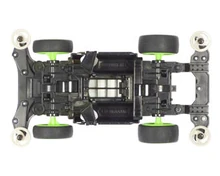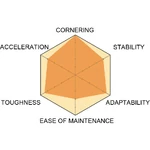No edit summary |
No edit summary Tag: Visual edit |
||
| (2 intermediate revisions by one other user not shown) | |||
| Line 1: | Line 1: | ||
| − | [[File:MS_Chassis.jpg|thumb|MS Chassis with N-02 nose and T-02 tail equipped.|220x220px]]The '''MS Chassis''' {{Translation|MSシャーシ|Emuesu Shāshi}} is a Mini 4WD chassis introduced by Tamiya in November 2005. It was the first double-shaft motor-driven chassis, and it was marketed exclusively under the [[Mini 4WD PRO]] car line-up. |
+ | [[File:MSChassisLogo.png|thumb|220x220px]][[File:MS_Chassis.jpg|thumb|MS Chassis with N-02 nose and T-02 tail equipped.|220x220px]]The '''MS Chassis''' {{Translation|MSシャーシ|Emuesu Shāshi}} is a Mini 4WD chassis introduced by Tamiya in November 2005. It was the first double-shaft motor-driven chassis, and it was marketed exclusively under the [[Mini 4WD PRO]] car line-up. |
== General info == |
== General info == |
||
| − | Instead of placing the motor on the front or the rear, the motor was relocated to the middle of the chassis. |
+ | Instead of placing the motor on the front or the rear, the motor was relocated to the middle of the chassis. In order to achieve this, Tamiya and SMC Motor co-developed a line of double-shaft motors for the new chassis, resulting in a 50/50 power transfer ratio. The batteries are now moved further to the sides of the chassis, with the motor itself in between. |
| − | The |
+ | The MS Chassis uses a modular design, divided into three main parts: the nose, centre and the tail. This allows for a variety of configurations, with three different nose and tail parts and two centre parts available. There also exists a bumper-less nose and tail module (N-03/T-03). |
| − | It has the short, 80 mm wheelbase as most compact chassis |
+ | It has the short, 80 mm wheelbase as with most compact chassis, resulting in better cornering. As all wheels are directly driven by the motor without the need of a propeller shaft, the MS Chassis has better torque than any chassis released so far. |
| − | + | One downside of the MS Chassis is its weight, which can be mitigated by using lightweight center parts. Another disadvantage is that since the chassis' basic layout is by and large fundamentally different from traditional Mini 4WD (i.e. front and rear motor) chassis, only parts that are bespoke to the chassis are compatible. And due to the motor and battery being placed at the middle of the chassis, narrow track large-diameter wheels are no longer compatible. |
|
The basic MS Chassis components would later reused and redeveloped in the [[MA Chassis]]. |
The basic MS Chassis components would later reused and redeveloped in the [[MA Chassis]]. |
||
== Technical info == |
== Technical info == |
||
| + | {{Chassis data |
||
| ⚫ | |||
| + | |Length = 154 mm (With N-01)<br>152 mm (With N-02 and N-04) |
||
| + | |Width = 92 mm |
||
| + | |Wheelbase = 80 mm |
||
| + | |Ground Clearance = 4 mm (With large-diameter wheels)<br>1 mm (With low-profile small-diameter wheels) |
||
| + | |Driveshaft Length = 60 mm<br>72 mm (N-04 and T-04 only) |
||
| + | |Gear Set = 4:1<br>3.7:1<br>3.5:1 |
||
| + | |Terminal Type = MS-type |
||
| ⚫ | |||
| + | |Down Thrust Angle = 5 |
||
| + | }} |
||
{{Chassis stats|Toughness = 4.4|Images = [[File:MSChassisStats.jpg|150 px]]|Acceleration = 3.9|Cornering = 4.9|Stability = 3.9|Adaptability = 4.5|Ease of Maintenance = 3}} |
{{Chassis stats|Toughness = 4.4|Images = [[File:MSChassisStats.jpg|150 px]]|Acceleration = 3.9|Cornering = 4.9|Stability = 3.9|Adaptability = 4.5|Ease of Maintenance = 3}} |
||
== Trivia == |
== Trivia == |
||
| − | * The N-04 and T-04 units were the only nose and tail units that |
+ | * The N-04 and T-04 units were the only nose and tail units that require 72 mm drive shafts, which, up until then, was made exclusively for [[Super X Chassis]]. |
* It is the first Chassis to have the new double-shaft motor. |
* It is the first Chassis to have the new double-shaft motor. |
||
| − | * Some bodyshells made for earlier chassis |
+ | * Some bodyshells made for earlier chassis require modifications in order to fit them into the MS Chassis. |
** At the launch of the MS Chassis car, Tamiya's staff accidentally listed [[Strato Vector]] (which required a front motor chassis) in the list of compatible bodyshells on the official website. It has been since removed. |
** At the launch of the MS Chassis car, Tamiya's staff accidentally listed [[Strato Vector]] (which required a front motor chassis) in the list of compatible bodyshells on the official website. It has been since removed. |
||
| − | * In |
+ | * In a patent Tamiya registered for the chassis, it shows that the chassis can be equipped with nose and tail units with different ground clearances and the nose unit can be swapped for the one with steering mechanism. It is unknown why Tamiya had scrapped those ideas for the actual chassis release.<ref>[https://www.google.com/patents/EP1852165B1 Patent EP1852165 B1 (MS Chassis) on Google Patent]</ref> |
== References == |
== References == |
||
| − | <references /> |
+ | <references /> |
| + | {{Navbox Chassis}} |
||
[[Category:Chassis]] |
[[Category:Chassis]] |
||
[[Category:Midship-motor chassis]] |
[[Category:Midship-motor chassis]] |
||
Latest revision as of 09:16, 11 July 2019


MS Chassis with N-02 nose and T-02 tail equipped.
The MS Chassis (Japanese: MSシャーシ, Emuesu Shāshi) is a Mini 4WD chassis introduced by Tamiya in November 2005. It was the first double-shaft motor-driven chassis, and it was marketed exclusively under the Mini 4WD PRO car line-up.
General info
Instead of placing the motor on the front or the rear, the motor was relocated to the middle of the chassis. In order to achieve this, Tamiya and SMC Motor co-developed a line of double-shaft motors for the new chassis, resulting in a 50/50 power transfer ratio. The batteries are now moved further to the sides of the chassis, with the motor itself in between.
The MS Chassis uses a modular design, divided into three main parts: the nose, centre and the tail. This allows for a variety of configurations, with three different nose and tail parts and two centre parts available. There also exists a bumper-less nose and tail module (N-03/T-03).
It has the short, 80 mm wheelbase as with most compact chassis, resulting in better cornering. As all wheels are directly driven by the motor without the need of a propeller shaft, the MS Chassis has better torque than any chassis released so far.
One downside of the MS Chassis is its weight, which can be mitigated by using lightweight center parts. Another disadvantage is that since the chassis' basic layout is by and large fundamentally different from traditional Mini 4WD (i.e. front and rear motor) chassis, only parts that are bespoke to the chassis are compatible. And due to the motor and battery being placed at the middle of the chassis, narrow track large-diameter wheels are no longer compatible.
The basic MS Chassis components would later reused and redeveloped in the MA Chassis.
Technical info
| Chassis Data | |
| Length | 154 mm (With N-01) 152 mm (With N-02 and N-04) |
| Width | 92 mm |
| Wheelbase | 80 mm |
| Ground Clearance | 4 mm (With large-diameter wheels) 1 mm (With low-profile small-diameter wheels) |
| Driveshaft Length | 60 mm 72 mm (N-04 and T-04 only) |
| Compatible Gear Set(s) | 4:1 3.7:1 3.5:1 |
| Roller Down Thrust Angle | 5 |
| Terminal Type | MS-type |
| Weight | With batteries: 124 g 123 g Without batteries: 70 g |
| Chassis Stats | ||
| Toughness | 4.4 | 
|
| Acceleration | 3.9 | |
| Cornering | 4.9 | |
| Stability | 3.9 | |
| Adaptability | 4.5 | |
| Ease of Maintenance | 3 | |
Trivia
- The N-04 and T-04 units were the only nose and tail units that require 72 mm drive shafts, which, up until then, was made exclusively for Super X Chassis.
- It is the first Chassis to have the new double-shaft motor.
- Some bodyshells made for earlier chassis require modifications in order to fit them into the MS Chassis.
- At the launch of the MS Chassis car, Tamiya's staff accidentally listed Strato Vector (which required a front motor chassis) in the list of compatible bodyshells on the official website. It has been since removed.
- In a patent Tamiya registered for the chassis, it shows that the chassis can be equipped with nose and tail units with different ground clearances and the nose unit can be swapped for the one with steering mechanism. It is unknown why Tamiya had scrapped those ideas for the actual chassis release.[1]
References
| Chassis | ||
|---|---|---|
| Original series | Origin · Comical · Wild · Cruiser · RV | |
| Type series (Racing/Truckin') |
Type-1 · Type-2 · Type-3 · Type-4 · Zero · FM · Truckin' · Type-5 | |
| Super series (Super/Mighty, Fully Cowled/Aero) |
Super-1 · Super-FM · Super TZ · Super X · VS · Super TZ-X · Super XX · Super-II | |
| Mini-F series | Mini-F | |
| R/C Mini 4WD | TR-1 | |
| PRO/REV/Laser | MS · AR · MA · FM-A · VZ | |